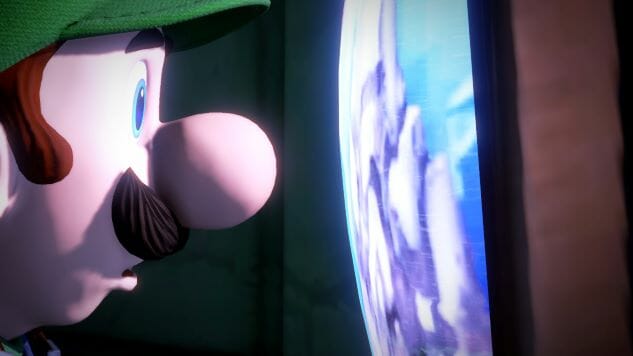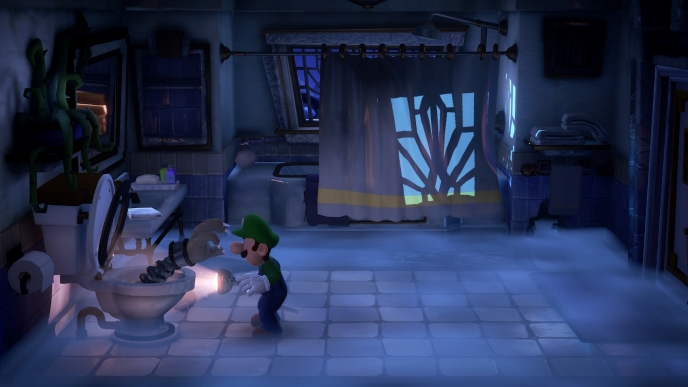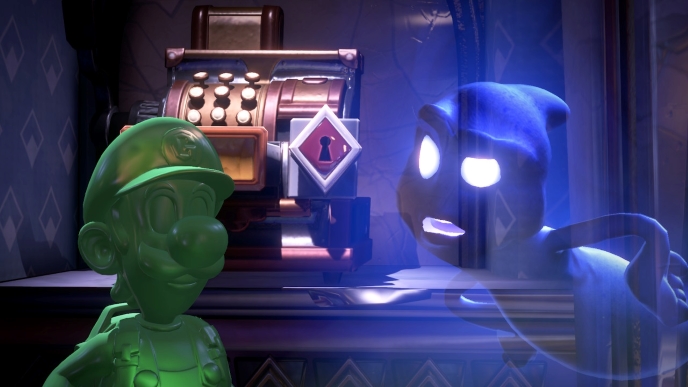
Luigi’s Mansion 3 is a game I’d want to find nestled in the snug, precise folds of wrapping paper my mother reserved for presents from Santa Claus (“because he actually has time for that”). It’s the kind of game that isn’t earth-shattering or overly-involved. The mechanics are simple, the story and characters gentle but expressive. It’s the kind of game you put on when everyone is exhausted from family and deep in a carbohydrate daze, but you just can’t bear to watch A Christmas Story one more time.
Which isn’t to say it’s not without its problems. But my time spent reviewing Luigi’s Mansion 3 pulled me out of the snit I was having with AAA games and reminded me how burrowing on the couch with a loved one and having fun with a simple, low-stakes game can be genuinely nourishing.
How often do you get to take a vacation to a haunted resort hotel, anyway?

Like Mario’s Gamecube-era trip to Isle Delfino in Super Mario Sunshine, Luigi’s third haunted adventure is a case of a vacation gone horribly wrong. He’s been invited to a remote resort that’s secretly a trap set by Luigi’s arch nemesis King Boo and spooky hotelier Hellen Gravely (yes, all the non-player characters have silly spooky names) to seal Luigi and company away in paintings. They get everyone but Luigi, and then it’s up to him to save the day…with a modular vacuum cleaner (and a new friend).
But this time, rather than a mansion (or series of mansions in a haunted village), Luigi must defeat the spectral staff and retrieve elevator buttons in a spooky luxury hotel
The Poltergust makes a return, and with it, the two primary verbs of the series: Suck and Blow. Used in conjunction with elements in the game world, and the judicious use of “Press X” interactive elements, the development team has managed to create intrigue, mystery, and a sense of wonder both in terms of puzzle design and the larger world. And when the controls aren’t fighting you (and they will fight you), it’s an inventive and delightful exploration game.
The hotel is a vast, spooky dollhouse—each floor a series of interlocking shadow box dioramas. And each shadow box is designed to be its own microscopic world. The level of craft and care that went into this endeavor results in a game world that feels undeniably real. I’ve been to this hotel—with the misguided Art Deco explosion as aesthetic, where adherence to theme overrode sound judgment, and there were one too many special amenity floors. The hotel in Luigi’s Mansion 3 has accounted for it all: there’s a nightclub, a garden, shopping, a museum of natural history, even a full-blown Medieval Times slapped in the middle of the towering Art Deco nightmare.
And where the expansiveness of thematic worlds in Super Mario Odyssey lends to a grand sense of scope (it’s a game about world tourism after all), here it has been repurposed and retrofit for an effect that captures the stifling, claustrophobic, and overwhelming nature of “luxury resorts.”

Luigi’s Mansion 3 is weird.
There’s an early boss fight against a mall cop. Unfortunately, it’s a shitty, regressive fat joke (that extends from his character design to his level design and even to his name—Krueller). But when Krueller is first introduced, he’s terrified. Absolutely shaking and an anxious wreck.
And then he finds a gun (okay, it’s a squirt gun), and his eyes light up, his posture changes, he’s empowered by the gun. Suddenly, the terrified rent-a-cop has decided he’s become John fucking Rambo.
Luigi’s Mansion 3 is full of these weird moments of almost-but-not-quite societal commentary.
Evidence of labor is everywhere in Luigi’s Mansion 3. Housekeeping and room service carts line hallways. Luggage waits to dutifully be delivered, chairs are stacked neatly upside down on top of cafe tables on the hotel’s 3rd floor shopping mall. The ghosts we vacuum up themselves seem to mostly be employees of the hotel in one way or another.
I’ve vacuumed up so many ghosts. A mechanic, kitchen staff, housekeeping, a DJ, a mall cop, a movie director (who did nothing to harm me at all, but left himself wide open). I spied on them. Luigi voyeuristically watched as one bathed (and then we kicked in the door and vacuumed them right up). Some of them were pranksters, others literally minding their own business until I stepped to and hit them with a materializing lightbulb strobe. The only truly shitty ones seem to be Hellen Gravely (literally a mean boss) and King Boo (literally a monarch) and the mall security ghost (literally a cop).
And then there’s the money. From a few coins to vast hordes of stacked bills, money is the chief collectable in Luigi’s Mansion 3. But as Patrick Klepek pointed out in his review for Waypoint, there’s practically no use for it. Which is interesting, as it raises some questions about the world the Mario brothers inhabit. The game states the ghosts don’t seem to have an interest in money, and yet they stockpile it, launder it (in the industrial hotel laundry rooms), hide it away in secret caches, and sometimes even inside their bodies.
Luigi has no real need for money. The only things to spend it on are bonus lives and collectable location map indicators, and the amount of wealth that Luigi can vacuum up in just the first hour of the game is phenomenal. It’s extraction of wealth for the pure extraction of wealth.
The game is clearly aware of relationships between power and luxury, labor and capital, state and corporation, bosses and employees. There are even nods to collective ownership? But the politics of the game are as inscrutable as the decision to make three of the D-pad buttons do nothing more than make Luigi say, “Mario?”
Nothing ever really comes together, but at times it doesn’t feel like the game wants to be understood. It’s happy to stretch its spooky arms across a hallway of meaning to poke at the player. One more series of puzzles to think about in your time away from playing.
Are ghosts really that bad? Are these ghosts? Are they defined by their jobs?
For all the depth and complexity of each room in Luigi’s Mansion 3, the one thing that struck me the most about its weird, indulgent world is that there aren’t any interesting collectables, no snippets of lore to be had, and the gallery doesn’t even offer a sentence or two about who these ghosts I’ve imprisoned in my Ghost Dyson are.
And it’s something that holds Luigi’s Mansion 3 back from being truly great. Between its diaphanous, shadowy politics and a refusal to use collectables or an encyclopedia to detail its world, no matter how much fun I was having, I kept feeling like the game had an emptiness despite its charm. I wanted more from this world, I wanted more for this world.
I wanted more for Gooigi.

Nobody was prepared for Gooigi. He captured the heart of the gaming internet for at least a week when jokes and fan art issued forth in ecstatic bursts (I am no saint here). And while his time in that spotlight may have concluded, I’m hard pressed to find a character whose actual presence in the game has compelled me more. In a cast of lovingly-created characters, from a company known for its ability to produce them, Gooigi stands out for me.
A creation of Dr. E. Gadd, little is directly said about Luigi’s gooey twin. He speaks in a distorted warbling mimicry of Luigi’s voice. He melts in contact with water, and bursts when he strays too far from Luigi. He has less health, but it replenishes on its own. He’s one of the most interesting additions to the Nintendo lineup in a while, and what agency he’s afforded is arguably less than even Resident Evil 4’s Ashley Graham. Where Luigi is given great depth of expression through only a handful of vocal assets and a putty-like facial structure, Gooigi is largely silent, blank-faced.
But what about Gooigi? Does he have hopes and dreams of his own? When he phases his gelatinous body through grates and fences to acquire money he’ll never spend, does it hurt—everytime? Will he ever know what it’s like to sip a cappuccino in the hotel café? Would indulging in the warm, jetted embrace of the ensuite jacuzzi be an act of self-annihilation, or of liberation? Nintendo isn’t interested in these questions about their jiggly new alter ego, not here at any rate, but I am. What does it mean that he always dutifully gives his fleshy doppelganger a solemn thumbs up before dissolving back into his holding tank when changing rooms? Why can’t he climb or open doors?
He’s a charming if solemn addition who exists to add complexity to multi-phasic puzzles, and he’s also the reason you get co-op in Luigi’s Mansion 3. And because I’m deeply invested in the sadness that seems to rake Gooigi’s existence, I tried to play as my quiet gooey friend whenever possible.

As a game critic, I don’t get to play games with my partner as often as I’d like. Especially if I’m reviewing, the time constraints make it difficult, even if a game has local co-op. But Luigi’s Mansion 3, we found, wasn’t just great to play together, but the ideal way to explore this haunted hotel. Single player is fine—it’s enjoyable. But this is a game that’s best shared.
There are tangible, obvious benefits to co-op. Switching between Luigi and Gooigi isn’t nearly as smooth as one would hope, and actions that require dual action are frustratingly slow without a partner. Some boss fights (and even just regular encounters and timed puzzles) become exhaustingly difficult with the game’s abysmal handling, and having a second player ready to strobe or draw attention can really be handy. Co-op absolutely takes the edge off the frustrating controls. And for players with limited manual dexterity (like me), I found having a player-controlled Gooigi could mean the difference between success and failure.
But it’s more than that.
At several points in writing this piece, I was coaxed back into picking up the second controller. There were more gems to find, Boos to vacuum, and rare ghosts we had yet to see. Putting our heads together to figure out puzzles that stumped us individually, trying to piece together the inscrutable politics of spectral capitalism, or teasing out what we could on the relationships this game is implying between power, labor, capital, and luxury.
You wouldn’t think just looking at it that Luigi’s Mansion 3 begs to be discussed both in play and when the console is off, and yet, it absolutely is.
But also, when the walls seem like they’re closing in, having a cozy experience to settle in under a blanket and explore is undeniably precious! Even just dropping in and out while each other played, often at a moment’s notice to take some ghostly heat off Luigi in a boss fight, reminded me of how joyous and warm local co-op can feel.
At its best, Luigi’s Mansion 3 brought me back to noticing the first flutters of snow through the living room window, sprawled next to a childhood friend playing Secret of Mana, wishing for school cancellation, that a weekend could last just one more day, if not forever. At worst, it was unanimously blaming the controller and sharing the frustration of a boss with too many phases—one that you just knew you’ll figured out together eventually—and a promise not to touch the save file until you’re reunited.
I do wish there were more to Luigi’s Mansion 3, that the controls were tighter and more precise, but I also find myself wanting to play it more despite these problems. I don’t know that I’ll pick it back up when my partner and I finally collect every last gem, and suck out every last coin from every possible hiding place. But the liveliness and charm of its world, the bizarre questions it doesn’t ask but gestures to, and the happiness I’ve had playing it with my partner on the couch will likely stick with me for quite some time.
Luigi’s Mansion 3 was developed by Next Level Games and published by Nintendo. It is available for the Switch.
Dia Lacina is a queer indigenous writer, photographer, and founding editor of CapsuleCrit.com, a monthly journal dedicated to microgenre work about games. She tweets too much at @dialacina.